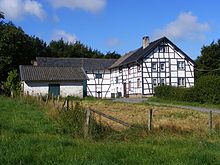Huppenbroich
|
Huppenbroich
community Simmerath
|
||
|---|---|---|
| Coordinates: 50 ° 35 ′ 26 ″ N , 6 ° 19 ′ 2 ″ E | ||
| Height : | 543 (524-546) m | |
| Residents : | 410 (December 31, 2011) | |
| Postal code : | 52152 | |
| Area code : | 02473 | |
|
Location of Huppenbroich in North Rhine-Westphalia |
||
|
Huppenbroich, seen from Kesternich
|
||
Huppenbroich is a district of Simmerath in the Aachen city region in North Rhine-Westphalia .
history
The place of origin of Huppenbroich is at the tributary of the Gössessief - Göselsief - Woffertssief and the Meißenbruch. Today the road to Huppenbroicher Flur 11 is at this point. More than 500 years ago, the location extended further to the northwest, in the direction of Simmerath.
In 1214, Duke Walram IV of Limburg , Herr von Monschau , married the widow Ermesinde II , the heiress of Luxembourg , after he was widowed . Among the guests was the knight Evrard de Meyssemburg , whose name is listed in a certificate. Because of military campaigns and harassment, the residents of Frohnrat and Mergenbür (Meisenbruch) had settled in Eicherscheid and Huppenbroich in 1334 . From this it can be concluded that the actual village of Huppenbroich already existed in 1334. It is documented that in 1369 the knight and nobleman Reinhard von Schönforst bequeathed the Montjoierländchen to his second oldest son provost Johann von Mastricht (literally: "borch, stat, lant ind whole holiness of Monjoye with eren allineghen zobehoeren, with the dorperen Vroenrath and Meysenbroich, destroyed , now Huppenbraich. ” ) In the vicinity of Huppenbroich there are remains of the Eicherscheid fiefdom, also known as Meyssenburg. At this time, the Lehnshof Huppenbroich already existed. With a document dated January 25, 1473, a Peter von der Hardt was given the Huppenbroich farm by Duke Gerhard von Jülich-Berg as a fief . According to a document dated June 26, 1550, the oldest residents of Huppenbroich, Heynen Meyss, 83 years old, and Johan Scheyr, between 60 and 70 years old, were heard. The extent of the tithe belonging to the feudal court should be determined. By 1568 the population must have increased to such an extent that the agricultural area was no longer sufficient to satisfy everyone. This is evident from the documents received. In the years around 1568, most of the forest was turned into arable land and meadows without permission. The Jülich authorities had the newly acquired land measured and leased.
In a list of names according to the forester's bill of 1647/48, the inhabitants of the individual places are listed who had to pay their taxes for firewood and fence wood. 25 names appear under the heading “Hoppenbroch” , which are probably heads of households. In 1730/31, Huppenbroich must have already consisted of 33 houses or households. It is noted that from "Huppenbroch" 33 heads of household swore the oath of allegiance when the rulers changed at that time. In 1799 Huppenbroich had 228 inhabitants and the number of houses was 41. This record was made when the village, like the entire Left Bank of the Rhine , was French. At that time the Rhine formed the border. Between 1803 and 1820 the Rhineland was mapped by Tranchot and von Müffling . Huppenbroich has also been recorded in map sheet 106.
The first public, community-owned school was built in Huppenbroich in 1852. At that time the place had 273 inhabitants.
The area of the Huppenbroich district , corridors 2, 11 and 12, totaled 486 hectares on October 10, 1936. At that time, Huppenbroich had 258 inhabitants. In 1944/41945 evacuation became necessary because of the Second World War . Almost all houses were destroyed by the war. Only a few were provisionally habitable in 1945.
Until 1960 the number of houses and residents had hardly changed. Nevertheless, time had left its mark; In terms of area, the place increased enormously in the years from 1945 to 1960. In the last few decades until 2010, however, the number of residents grew steadily and the number of buildings has multiplied exponentially.
Culture and sights
- In Huppenbroich there is a chapel and a small village pond. There are also a number of monuments in and around the town.
- Ground monument fortification Meyssenburg right would be fiefdom Eicherscheid
- Another attraction is the SAKRALA - Eifel Museum for Christian folk and church art
swell
- Bongard, Erich: The story of Huppenbroich , to be read on Huppenbroich.de




